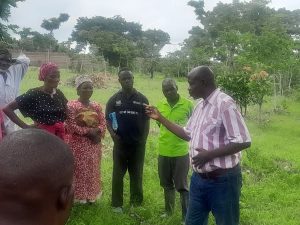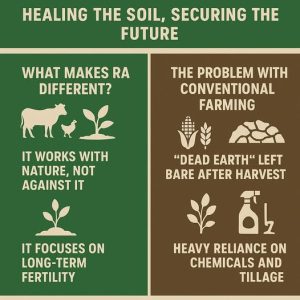“The battle for the future of farming is not just above the ground – it is deep within the soil.”
Farming today stands on two roads:
– One that takes from the land until there’s nothing left.
– And one that gives back, restoring balance and abundance.
Let’s break it down ![]()
—
![]() Conventional Farming – The Soil Drainer
Conventional Farming – The Soil Drainer
Most conventional farming systems rely on:
– High-input, fast-growing crops like maize, soy, and wheat.
– Synthetic fertilizers, pesticides, and herbicides to force growth.
– Heavy tillage, breaking up the soil structure over and over again.
– Monoculture – growing the same crop repeatedly on the same land.
![]() What this does to the soil:
What this does to the soil:
– Destroys organic matter, the life-giving sponge of the soil.
– Kills beneficial microbes, fungi, and earthworms that keep soil alive.
– Leaves the land bare after harvest – exposing it to erosion and heat.
– Creates dependence on more chemicals just to keep yields up.
The result?
![]() Soil that once supported life turns into dust and hardpan – lifeless, dry, and toxic.
Soil that once supported life turns into dust and hardpan – lifeless, dry, and toxic.
And when the rains come?
![]() The water runs off instead of soaking in. Floods come faster. Droughts last longer. Crops fail. Farmers suffer.
The water runs off instead of soaking in. Floods come faster. Droughts last longer. Crops fail. Farmers suffer.
—
![]() Regenerative Agriculture (RA) – The Soil Builder
Regenerative Agriculture (RA) – The Soil Builder
RA flips the script by asking:
“How do we work with nature to make soil better every season?”
RA practices include:
– Cover crops to keep soil protected and enriched.
– Rotational grazing to naturally fertilize and stimulate plant growth.
– Minimal or no tillage to preserve soil structure and moisture.
– Crop diversity and perennials to keep roots alive year-round.
![]() What this does to the soil:
What this does to the soil:
– Rebuilds organic matter, feeding billions of soil microbes.
– Increases water retention – reducing both flood and drought risk.
– Supports plant health, reducing disease and pest pressure.
– Captures carbon from the atmosphere, cooling the climate.
The result?
![]() Living soil that grows stronger, not weaker, every year.
Living soil that grows stronger, not weaker, every year.
Farmers using RA report better yields, lower costs, and greater resilience.
—
![]() Why Every Farmer Must Pay Attention
Why Every Farmer Must Pay Attention
This is no longer theory. Across Africa and the world, farmers practicing RA are seeing real results:
– Their soil holds more water during dry spells.
– They need fewer chemical inputs.
– Their land resists erosion even in heavy rains.
– They are feeding their families and local markets with pride.
In contrast, farmers stuck in the conventional system are finding it harder and harder to survive – the soil just can’t give what it no longer has.
—
![]() Final Word:
Final Word:
Farming isn’t just about what we plant above the soil. It is about what we build below it.
Choose the path that regenerates, not the one that depletes.
—
![]() Coming Next:
Coming Next:
Episode 3: Why RA Is the Future – Benefits Beyond the Farm
We’ll dive into how RA helps combat climate change, lowers costs, and builds a food-secure, economically stronger future.





